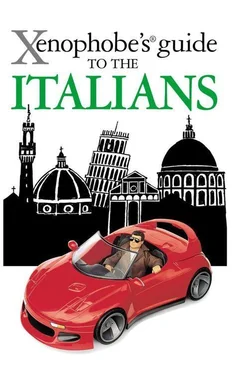Martin Solly - Xenophobe's Guide to the Italians
Здесь есть возможность читать онлайн «Martin Solly - Xenophobe's Guide to the Italians» весь текст электронной книги совершенно бесплатно (целиком полную версию без сокращений). В некоторых случаях можно слушать аудио, скачать через торрент в формате fb2 и присутствует краткое содержание. Год выпуска: 2008, ISBN: 2008, Издательство: Oval Books, Жанр: geo_guides, на английском языке. Описание произведения, (предисловие) а так же отзывы посетителей доступны на портале библиотеки ЛибКат.
- Название:Xenophobe's Guide to the Italians
- Автор:
- Издательство:Oval Books
- Жанр:
- Год:2008
- ISBN:9781908120618
- Рейтинг книги:5 / 5. Голосов: 1
-
Избранное:Добавить в избранное
- Отзывы:
-
Ваша оценка:
- 100
- 1
- 2
- 3
- 4
- 5
Xenophobe's Guide to the Italians: краткое содержание, описание и аннотация
Предлагаем к чтению аннотацию, описание, краткое содержание или предисловие (зависит от того, что написал сам автор книги «Xenophobe's Guide to the Italians»). Если вы не нашли необходимую информацию о книге — напишите в комментариях, мы постараемся отыскать её.
Xenophobe's Guide to the Italians — читать онлайн бесплатно полную книгу (весь текст) целиком
Ниже представлен текст книги, разбитый по страницам. Система сохранения места последней прочитанной страницы, позволяет с удобством читать онлайн бесплатно книгу «Xenophobe's Guide to the Italians», без необходимости каждый раз заново искать на чём Вы остановились. Поставьте закладку, и сможете в любой момент перейти на страницу, на которой закончили чтение.
Интервал:
Закладка:
Football is far and away the most important sport in Italy. Matches are played on Sunday afternoons and Italian men are often to be seen holding radios to their ears as they take their family out for a Sunday afternoon stroll. When the national team is playing in the World Cup, the whole nation comes to a halt and everybody forgets their regional differences – in front of the television. The only other sport taken seriously at a national level is cycling, and the progress of the Italian competitors in the Giro d’Italia and the Tour de France is followed (despite doping scandals), with rapt attention.
“Beautifully dressed Italian joggers are easily overtaken by the average walker.”
The Italians are not brought up with much active sport apart from physical education classes – few Italian schools have good sports facilities – and it is hard to find anyone participating seriously in sport. Beautifully dressed Italian joggers are easily overtaken by the average walker as they flaunt their way around the park on a Sunday morning. Nevertheless, Italy regularly manages to produce world and Olympic champions in a whole variety of sports, from swimming and fencing to rowing and shooting, with both the competitors and their country relishing and making the most of every opportunity for occupying the centre stage.
Culture
Italians have enormous respect for culture. They know the value of their national heritage and that it is one of the main sources of their country’s wealth.
Money is, and always has been, a driving force behind Italian creative art, but it is not the only one. Religion, a sense of beauty, and a gift for understanding the spirit of place are also important. Perhaps the most important of all is the Italian’s innate pride in making something beautiful – fatta a regola d’arte . Things don’t necessarily have to work well, they don’t necessarily have to last, but they have to look good. And if they are beautiful, the Italians will make the effort to make them work well and to make them last.
“Italian life is, and always has been, melodramatic, which helps explain the popularity of operas.”
This is the link between a dress by Valentino, a car by Pininfarina, a glass gondola blown in a small workshop on one of the islands in the Venetian lagoon, a roadside madonna and child, and a plate of fresh pasta.
Italian prisoners of war on the Orkney Islands during World War II were given a Nissen hut to use as their chapel. They carefully decorated the inside, painting it with baroque trompe l’oeil and turning it into a work of art. Sixty years later, ex-prisoners regularly return to make sure their chapel is still beautiful.
Italian life is, and always has been, melodramatic, which helps explain the popularity of operas of the 19th century and soap operas of today. Plumbers can be heard singing well-known arias while they work, and cleaning ladies save their pennies for a ticket to dress up to the nines and attend La Scala. Karaoke enjoyed an incredible boom in Italy, giving ordinary Italians a wonderful opportunity to satisfy their narcissism by being ‘on show’. What could be more fun than singing your heart out in front of your friends and family?
If the Italians didn’t actually invent trash television, they have certainly developed it to a fine art. Even on the three national channels there is a lack of finesse that would be considered really slapdash anywhere else. Viewers are often treated to completely blank screens, and programmes regularly start several minutes later than scheduled. Newscasters are frequently caught reading items that have no relation to what is happening on the screen.
“Viewers are often treated to completely blank screens.”
Italian viewing is mainly made up of films, cartoons and soap operas, which have been imported and dubbed. The dubbing can be appalling: in the love scene from A Fish called Wanda , even John Cleese’s utterances in Russian, which were supposed to excite Jamie Lee Curtis to a frenzy, were rendered into Italian.
On the other hand, the astonishing success of second-rate American soap operas in Italy is largely due to the real passion of the Italian versions, where the dubbing has served to cover up the poor quality of the original dialogue. The Italian version of The Bold and the Beautiful resulted in its little-known American stars achieving cult status in Italy and being better known than the members of the government.
“The astonishing success of second-rate American soap operas in Italy is largely due to the real passion of the Italian versions.”
Most home-grown productions are variety shows which cater for so-called ‘family viewing’ and as Italian children are usually still up and about at 10.30 p.m., they tend to go on interminably all evening, offering the same basic ingredients of quizzes, games and competitions interspersed with song and dance routines and advertisements. The first Italian Big Brother ( Grande Fratello ) was enormously successful, the third and fourth less so, as the novelty wore off. Other highly successful programmes include the various talk shows in which ordinary people air their personal problems, which are then discussed at length. The problems tend to focus on the national obsessions of love and betrayal, food and football, health and security; and the more heated the debate, the higher the audience ratings seem to rise.
The alternatives for family viewing are dubbed Walt Disney imports and wildlife documentaries. Despite being great Europeans, when it comes to light music the Italians prefer the home-grown variety. Not only does Italy not send a team to the Eurovision Song Contest, but the great majority of Italians have never even heard of it. They prefer their own Italian song contest, which is held in the city of San Remo on the Riviera every February. It lasts a whole week and draws huge television audiences.
“Despite being great Europeans, when it comes to light music the Italians prefer the home-grown variety.”
Other programmes take their cue from Candid Camera and give viewers the chance to see unwitting participants reduced to tears and rage without knowing they are being watched by an audience of millions. In Complotto di Famiglia (Family Conspiracy) for instance, Maria accompanies her husband to an important business dinner for the first time. As the evening progresses, it becomes increasingly clear that the glamorous hostess in a tight pink suit is paying too much attention to Maria’s husband. At a certain point she asks Maria to ‘lend her husband to her for a bit’. The husband seems to acquiesce. The ensuing scene is fraught with anguish and emotion, but the programme ends before viewers can see whether or not Maria and her husband manage to save their marriage.
“It combines titillation with a daily dose of the two things Italians enjoy most in life – debunking their politicians and laughing at others’ mistakes.”
Late-night viewing is for adults only, and ‘high quality’ films compete with sleazy strip shows where ‘housewives’ take their clothes off to win bonus prizes. Among the most successful programmes are the gameshow, Affari tuoi , the Italian version of Deal or No Deal and a programme called Striscia la notizia , which devotes half an hour each evening to investigating complaints made by callers, as well as showing and commenting on a cunningly edited collation of recently televised news and events adorned by two skimpily clad show girls whose miniscule outfits just manage to stay on during their dance routines. Presented in this way it combines titillation with a daily dose of the two things Italians enjoy most in life – debunking their politicians and laughing at others’ mistakes.
Читать дальшеИнтервал:
Закладка:
Похожие книги на «Xenophobe's Guide to the Italians»
Представляем Вашему вниманию похожие книги на «Xenophobe's Guide to the Italians» списком для выбора. Мы отобрали схожую по названию и смыслу литературу в надежде предоставить читателям больше вариантов отыскать новые, интересные, ещё непрочитанные произведения.
Обсуждение, отзывы о книге «Xenophobe's Guide to the Italians» и просто собственные мнения читателей. Оставьте ваши комментарии, напишите, что Вы думаете о произведении, его смысле или главных героях. Укажите что конкретно понравилось, а что нет, и почему Вы так считаете.












